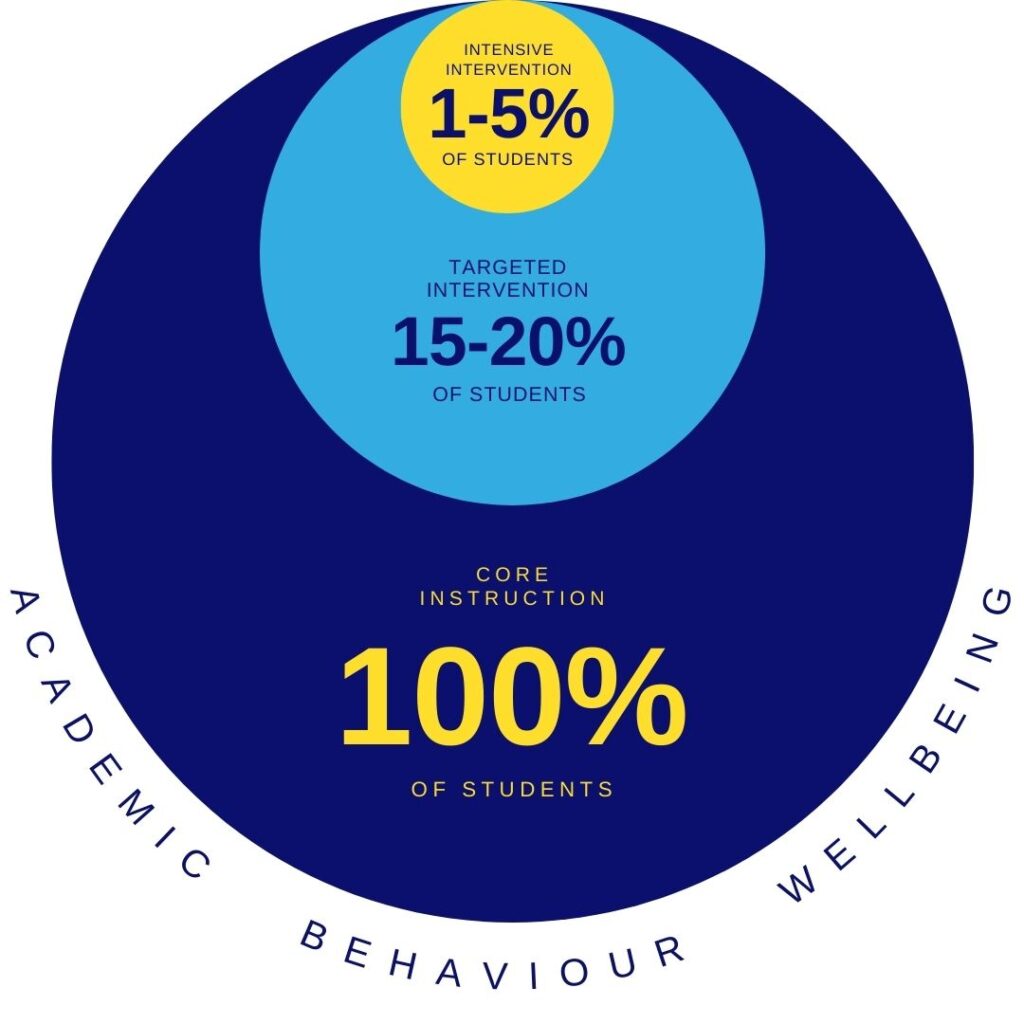RtI Table
Current as of 09/12/22
| |
Academic
|
Behaviour
|
Wellbeing
|
|
Tier 3
(5% of students)
INTENSIVE
INTERVENT-ION
|
- Access to specialised services/advice provided by school/SSS;
– speech therapist
– psychologist
– visiting teacher
- Recommendation to look at possible formal diagnosis through paediatrician, SPELD Victoria, psychologist etc.
- Offer regular Student Support Group (SSG) Meetings to discuss IEPs and progress
- Participate in extension programs outside of classroom
- Access DI funding for additional classroom support through ES staff
- Small group sessions with NLPS speech therapist
- Provide assistive technology when required (e.g. C-pen, iPad, keyboard)
- Participate in High Ability programs (see schedule)
|
- Access to specialised services/advice provided by school/SSS;
– speech therapist
– psychologist
– visiting teacher
- Create and implement a Behaviour Support Plan and meet with parents to discuss/review
- Track behaviour (e.g. ABC Chart) / enter data on Compass – red rating
- Recommendation to look at possible formal diagnosis through paediatrician, psychologist etc.
- Access DI funding for additional classroom support through ES staff
- Refer to CAMHS
- DFFH Care Team Meetings
- Offer time in the ‘Chill Room’ during play times
- Provide resources to assist in managing sensory needs e.g. headphones
- Regular check ins with student by Principal / Assistant Principal
|
- Access to specialised services/advice provided by school/SSS;
– speech therapist
– psychologist
– visiting teacher
- Recommendation to look at possible formal diagnosis through paediatrician, psychologist etc.
- Refer to RCH and/or CAMHS
- DFFH Care Team Meetings
- Offer time in the ‘Chill Room’ during play times
- 1:1 sessions with NLPS Student Welfare Officer
- Provide resources to assist in managing sensory needs e.g. headphones
- Offer regular Student Support Group (SSG) Meetings to discuss IEPs and progress
|
|
Tier 2
(15-20% of students)
TARGETED
INTERVENT-ION
|
- Establish an IEP and discuss concerns and strategies with parents
- Literacy Support Groups
- Numeracy Support Groups
- G.R.i.N.
- Have student information filed in ‘Student Welfare’ Folder on Google Drive to allow for all relevant staff to access
- Small group sessions with NLPS speech therapist
|
- Restorative Discussions with student/s involved
- Enter data on Compass – amber rating
- Discuss concerns and strategies with parents
- Set individualised goals then implement through a ‘Good Behaviours for Learning Chart’ / ‘Reward Chart’
- Have student information filed in ‘Student Welfare’ Folder on Google Drive to allow for all relevant staff to access
- Provide calm corner/space in the classroom
|
- Establish an IEP and discuss concerns and strategies with parents
- Have student information filed in ‘Student Welfare’ Folder on Google Drive to allow for all relevant staff to access
- Responsive lessons from Health Curriculum
- Small group sessions with NLPS Student Welfare Officer
- Provide calm corner/space in the classroom
- Display asthma/ anaphylaxis/ epilepsy/ diabetes plans
|
|
Tier 1
(100% of all students)
CORE INSTRUCT- ION
|
- Differentiated literacy and numeracy programs (including catering for enabling and extension)
- Identify students at risk through assessments
- Assess literacy and numeracy skills against VC and KAIs twice a year
- Staff P.L.
- Detailed handover at beginning of year between staff
|
- School Values
- Respectful Relationships
- NLPS SWPBS Matrix
- Assess social skills against VC twice a year
- Staff P.L.
- Detailed handover at beginning of year between staff
- Restorative approach to managing behaviour
|
- Health Curriculum
- Circle Time
- Bounce Back program
- Respectful Relationships program
- Identify students at risk though the ‘Student Wellbeing Tool’ register – review at least once a term
- Staff P.L.
- First Aid Officer
- Marrung Education Plan
- Parent Information Sessions
- SEL also in Library Sessions
- Detailed handover at beginning of year between staff
|
Acronyms
VC – Victorian Curriculum
KAIs – Key Assessment Indicators
SWPBS – School Wide Positive Behaviour Support
G.R.i.N. – Getting Ready in Numeracy
SSG – Student Support Group Meeting
IEP – Individual Education Plan
SSS – Student Support Services (part of the DET)
RCH – Royal Children’s Hospital
CAMHS – Child and Adolescent Mental Health Service
DI – Disability Inclusion
ABC Chart – Antecedent Behaviour Consequence Chart
DFFH – Department of Families, Fairness and Housing
ES Staff – Education Support Staff
Staff PL – Staff Professional Learning
SEL – Social and Emotional Learning

